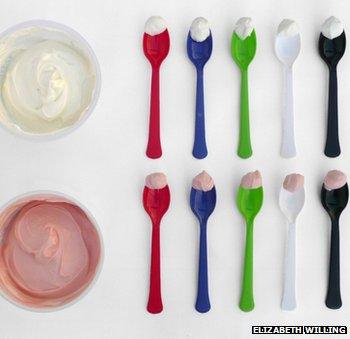Cutlery 'can influence food taste'
- Published

The colour of the spoon has an impact
Our perception of how food tastes is influenced by cutlery, research suggests.
Size, weight, shape and colour all have an effect on flavour, says a University of Oxford team.
Cheese tastes saltier when eaten from a knife rather than a fork; while white spoons make yoghurt taste better, experiments show.
The study in the journal Flavour , externalsuggests the brain makes judgements on food even before it goes in the mouth.
More than 100 students took part in three experiments looking at the influence of weight, colour and shape of cutlery on taste.
The researchers found that when the weight of the cutlery conformed to expectations, this had an impact on how the food tastes.
For example, food tasted sweeter on the small spoons that are traditionally used to serve desserts.
Colour contrast was also an important factor - white yoghurt eaten from a white spoon was rated sweeter than white yoghurt tasted on a black spoon.
Similarly, when testers were offered cheese on a knife, spoon, fork or toothpick, they found that the cheese from a knife tasted saltiest.
"How we experience food is a multisensory experience involving taste, feel of the food in our mouths, aroma, and the feasting of our eyes," said Prof Charles Spence and Dr Vanessa Harrar.
"Even before we put food into our mouths our brains have made a judgment about it, which affects our overall experience."
Past research has shown that crockery can alter our perception of food and drink.
For example, people generally eat less when food is served on smaller plates.
The new research into how the brain influences food perceptions could help dieters or improve gastronomic experiences at restaurants, said Prof Spence.
He told BBC News: "There's a lot more to food than what's on the plate. Many things we thought didn't matter do. We're going to see a lot more of neuroscience design around mealtimes."
- Published4 July 2012
- Published7 February 2013